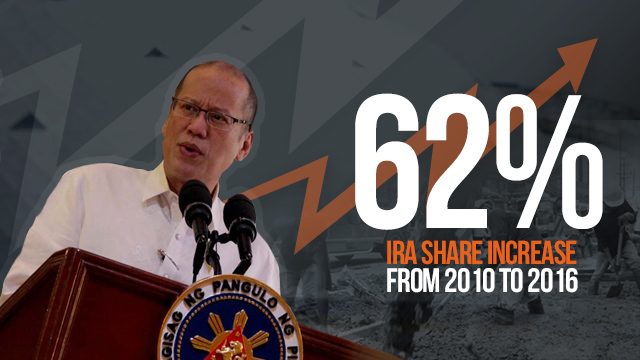SUMMARY
This is AI generated summarization, which may have errors. For context, always refer to the full article.

MANILA, Philippines – For 2016, the country’s 43,000 local government units (LGUs) – from provinces down to barangays – have a P428.62-billion ($8.96-billion) share in the internal revenue allotment (IRA).
The amount represents 14.28% of the P3-trillion ($62.72-billion) national budget this year, and a 62% increase from the P265.80-billion ($5.56-billion) IRA during President Benigno Aquino III’s first year in office, the Department of Budget and Management (DBM) said.
The IRA for the current year is computed based on the collection of the national government 3 years earlier, as prescribed in Section 284 of the Local Government Code.
This means the collections on which the IRA is based that the Aquino government is responsible for started only in 2013. The P1.217 trillion ($25.44 billion) collected by the Bureau of Internal Revenue in 2013 is the basis of the IRA share that LGUs will enjoy this year.
Under the Local Government Code, LGUs receive 40% of the national government’s IRA every year. The amount equivalent to that 40% is divided between LGUs this way: 23% for provinces, 23% for cities, 34% for municipalities, and 20% for barangays.
From the latest count of the National Statistics Coordination Board, the 2016 IRA should be divided among 81 provinces, 144 cities, 1,490 municipalities, and 42,036 barangays.
Campaign promise
The IRA received by local governments in the first half of Aquino administration were based on BIR’s collection under the administration of President Gloria Arroyo. The LGUs received P265.8 billion ($5.56 billion) in 2010, P286.94 billion ($5.999 billion) in 2011, and P273.31 billion ($5.71 billion) in 2012.
Since the first Aquino administration-generated IRA in 2013, LGUs have been enjoying around 10-15% increase in their internal revenue allotments every year. Local governments received P302.3 billion ($6.32 billion) in 2013, P341.55 billion ($7.14 billion) in 2014, P389.86 billion ($8.15 billion) in 2015, and P428.62 billion ($8.96-billion) in 2016. (READ: LGUs’ IRA rose in the last 5 years – LMP)
Increase in allotment is attributed to higher collections by the Bureau of Internal Revenue. Tax revenues collected in 2013 increased to P1.217 trillion ($25.44 billion) from P1.058 trillion ($22.12 billion) in 2012 following the implementation of the six tax reform law despite consistently missing collection targets.
Those collected in 2011 climbed to P940 billion ($19.65 billion) from P822.6 billion ($17.19 billion) and P750.3 billion ($15.68 billion) for years 2010 and 2009, when the economy was still reeling from the impact of the 2007-2008 global financial crisis. (READ: First Aquino-generated IRA highest for LGUs in 3 years)
Higher allotment for LGUs is in line with the position stated by Aquino during his presidential campaign. He said LGUs could get higher amounts of IRA through efficient tax collection on the part of the national government, and there wasn’t necessarily a need to increase their percentage share in the BIR collection.
Gains for infra and social services
According to Budget Secretary Florencio Abad, efficient tax collection made the increase in IRA share possible. “This means more gains in terms of infrastructure build-up and social services in local communities,” he said in a press release on Wednesday, January 13, 2016.
“On top of the CCT, KALAHI-CIDSS, PhilHealth, and the innovative Bottom-up Budgeting projects, the increase in IRA can only mean more capacity for LGUs to provide social services and local infrastructure projects for local communities,” Abad said.
Under the administration of President Gloria Arroyo, the release of IRA became automatic and direct to the LGUs, on a quarterly basis, to avoid delays and the propensity of higher local chief executives for using it as political tool against lower-level local officials.
Since 2012, the DBM has been comprehensively releasing the IRA of LGUs at the start of every year. The budget department and the Department of Finance adopted the policy of direct release, which allowed the IRA share be downloaded from the Bureau of Treasury straight to the bank accounts of LGUs monthly.
According to the DBM, this policy is more efficient compared to the 1991 Local Government Code mandate of requiring releases to be done quarterly. – Rappler.com
*US$1 = P47.85
Add a comment
How does this make you feel?
There are no comments yet. Add your comment to start the conversation.